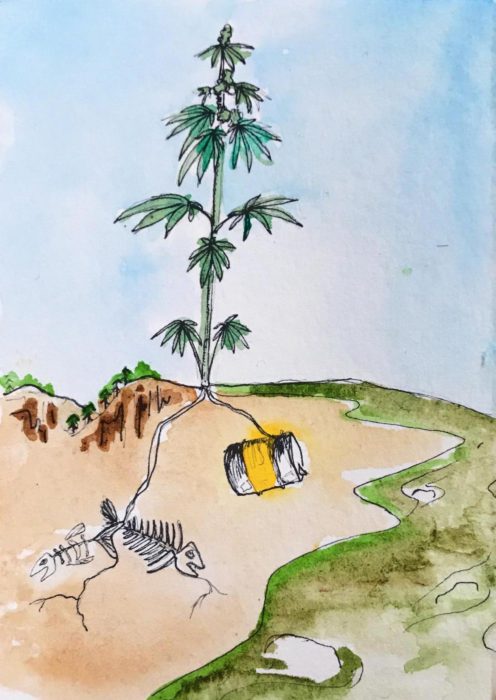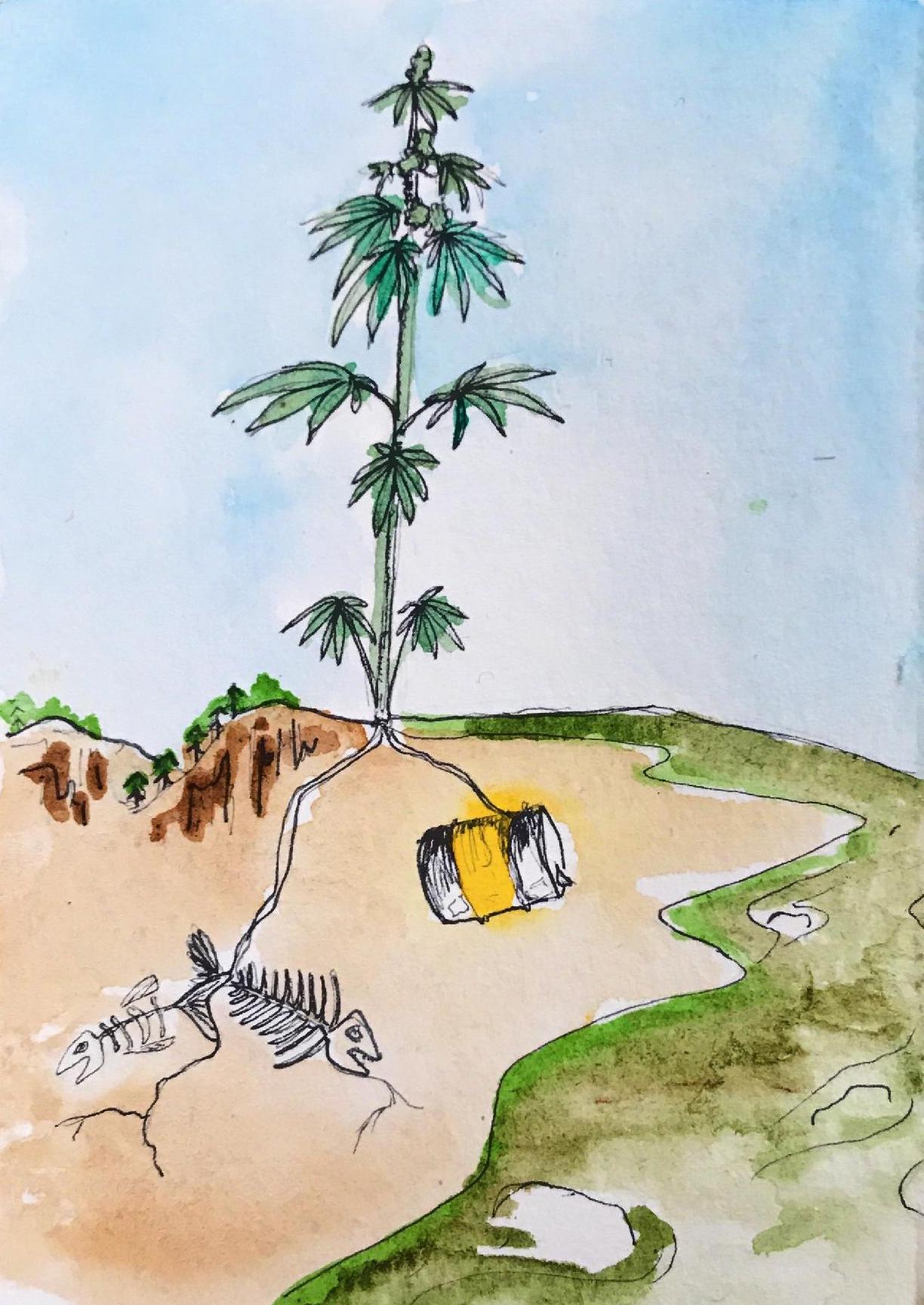
In the summer of 2014, Scott Bauer kneeled in the gravel bed of an Eel River tributary to examine the emaciated body of a dying steelhead trout. It was the time of year when juvenile salmon and steelhead usually depend on pools left behind from spring rains, but that year, those pools had already dried up.
Bauer, a senior scientist for the California Department of Fish and Wildlife, had reason to think the historic drought was to blame for the fish’s demise. But after he and a research team assessed aerial imagery and mapped dried streambeds, he found another threat to the struggling fish in Humboldt County: thousands of illegal cannabis farms.
“These operations were essentially taking the cold, clean water that salmon and steelhead need to thrive,” Bauer said.
In the few years since, scientists like Bauer have begun to illuminate the potential adverse relationship between endangered fish and growing marijuana. A quarter of California’s native inland fish species are listed as endangered, with 25 of the state’s 32 salmonids projected to vanish from the state within the next century, according to research from the University of California, Davis. In Northern California, the five forks of the Eel River host threatened populations of coho and chinook salmon and steelhead trout, right alongside the largely unregulated black market of cannabis farming.
Medical marijuana has been legal in California since 1996, and, in 2016, the state legalized recreational use. Today, as California figures out how to regulate its legalized cannabis industry, environmentalists have begun to pressure regulators to think of the fish.
“We can’t let wild native salmon and steelhead go extinct,” said Stephanie Tidwell, executive director of Friends of the Eel River. “We have to do what we need to do. But that bill is more than some people want to pay.”
After all, just like salmon, cannabis is deeply embedded in the region’s DNA. In the 1960s, California’s countercultural outlaws established marijuana grows in what has come to be known as the Emerald Triangle, comprised of Humboldt, Mendocino, and Trinity Counties.
“The backwoods of Mendocino and southern Humboldt became an inviting opportunity for the hippies looking for a way to build a better world, to go back to nature,” said Scott Greacen, a lawyer and conservation director for Friends of the Eel River. There’s nothing particularly significant about the growing conditions in this region; Greacen suspects many operations truck in soil from elsewhere. But the remote and expansive mixed-conifer hills of Northern California offered the perfect setting to shelter clandestine farms.
Then in 1996, California passed the Compassionate Use Act that legalized medicinal marijuana use, pushing the industry into a semilegal gray area when it came to agricultural regulations. Without a clear picture of how many farms existed — let alone their environmental impacts, cannabis became a cash cow in a region known for boom and bust.
“Our best guess is that we were seeing the number of grows double every three years,” said Greacen. “The average size of the operations were increasing as well.”
University of California, Berkeley researchers estimate that, between 2012 and 2016, cannabis farms in Northern California increased in number by 58 percent, while the total area under cultivation increased 91 percent.
In January 2018, California began issuing commercial licenses to cultivators following recreational legalization. Bauer and others at California Fish and Wildlife saw this as an opportunity to bring the industry into environmental compliance. The agency began hosting cultivation permitting workshops, which discussed ways to mitigate environmental impacts. Permits come with certain regulations on water diversions, such as a requirement for water-storage infrastructure to lay off streams during the dry summers.
But according to Ted Grantham, a UC Berkeley hydrologist and freshwater ecologist, water use isn’t the sole problem. “It’s more about where cannabis is grown than anything,” he said. “These remote watersheds have a lot of sensitive habitat, and this region has steep, erodible slopes.”
In other words, water diversion is certainly a problem, but Grantham suspects that sedimentation is the larger issue. Dirt and runoff from road-building and land-clearing can bury and clog cobble beds where salmonids lay their eggs. The sediment can also prevent juvenile fish from finding their food.
“It doesn’t take much to cause downstream impacts to an aquatic ecosystem,” said Grantham. He admits, however, that it’s not yet clear how much the cannabis industry is responsible for this sedimentation. Much of the road network, albeit poorly maintained, was created by the post-war logging industry, for instance.
Regardless, many environmentalists see current regulations from state and county offices as insufficient. In June 2018, Friends of the Eel River filed a lawsuit against Humboldt County. The county had just passed a new land-use ordinance, which aimed to issue 3,500 permits to environmentally compliant commercial cannabis operations. The lawsuit argued that this ordinance failed to assess the impacts of the existing black-market industry, which Friends argued had already outgrown the ecosystem’s carrying capacity.
“Land-use decisions need to be based on the facts on the ground,” Tidwell said. “We want the government to look at the watersheds, especially where salmon and steelhead are suffering, and assess what [the environment] can handle and permit accordingly. Some sites are just not suited for commercial activities. Period.”
For Greacen, the answer is federal legalization. “Until we really have a legal federal market, there’s going to be sufficient demand to continue to drive a lot of the black-market operations here to keep cutting corners,” he said.
Like many ecological problems, the situation facing salmon in the Emerald Triangle is a complicated one. According to Grantham, it’s difficult to separate impacts of cannabis farming from other factors, like climate change.
Rigorous scientific work like Bauer’s is a start, as is the research from UC Davis ecologist Mourad Gabriel, who has traced rodenticide contamination from marijuana farms to wildlife food webs. In January, Grantham and a team of natural and social scientists at UC Berkeley launched the Cannabis Research Center, targeted at these very questions of environmental impacts from the industry. The magnitude of cannabis as an agricultural industry, center co-director Van Butsic wrote in one report, “demands that it be researched and regulated on par with conventional agriculture,” particularly as the policies surrounding it rapidly evolve.
For his part, Bauer thinks there already is progress happening, at least with water. “In the past four years, we’ve seen a tremendous amount of change,” said Bauer. “People have bought into the idea that if you want to grow cannabis, you need to protect public trust resources.”
But more work remains. “Growers are putting lights in their greenhouses and using generators, basically [creating] stadiums in the woods,” said Bauer, indicating concern for another endangered species: the spotted owl. “The issues are constantly changing. Hopefully we can keep advancing the science and [regulations], and do so in a way that protects the environment.”

